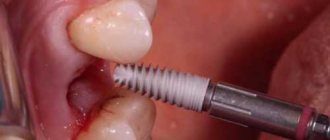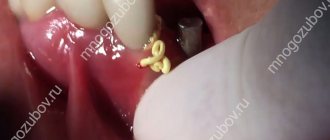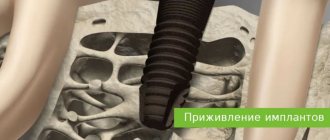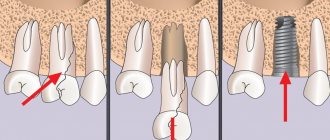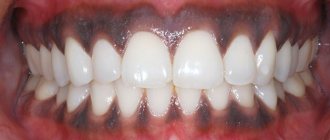What is autologous dental transplantation?
This is a unique surgical operation performed by doctors at our clinic.
Autotransplantation is a procedure in which a healthy tooth is taken from a patient from an area where it is less functional (wisdom tooth, supernumerary tooth). This tooth becomes a donor. It is transplanted to a place where there is a great need for it - if tooth extraction is required (severely damaged tooth, root crack, etc.). That is, autotransplantation is an alternative to traditional implantation. Instead of implanting an implant, your own natural tooth is implanted.
Attention: such a transplant is not possible in all cases; the indications will be determined at a personal appointment and after diagnosis.
Direction: Surgery and implantation
0/0
Autotransplantation is the transplantation of your own tooth. Photo before deletion
After treatment. We implanted a wisdom tooth in place of the extracted tooth.
Doctor: Shirnaliev Ulvi
Direction: Surgery and implantation
0/0
Autotransplantation is the transplantation of your own tooth. Photo before treatment.
A root crack was diagnosed and the tooth was removed.
We implanted a wisdom tooth in place of the extracted tooth.
Doctors: Unzhakova Yulia Kobozev Mikhail
Direction: Surgery and implantation
0/0
Autotransplantation is the transplantation of your own tooth. Before treatment (cracked root of the sixth tooth).
Tooth removed, fitting of wisdom tooth template.
We implanted a figure eight in place of the extracted tooth.
New tooth - after endodontics.
Doctors: Unzhakova Yulia Kobozev Mikhail
Main types of implantation
Valentina
When I decided to replace the old bridge with implants, I thought that the procedure was the same for everyone - they inserted an implant and put a prosthesis on it. But during the consultation I realized that this is really a whole science, an individual program is selected for everyone. So, for example, I was offered classical implantation. Now I’m waiting for complete engraftment, and I’m getting ready to use metal-ceramics. I hope this is forever!
Dmitriy
I had a classic implantation of one tooth. I am a supporter of proven and well-studied technologies, so I chose this option instead of the newfangled non-surgical implantation. I was afraid - it’s not a cheap idea, it’s better to do it “classically”.
Natalia
I wanted to get two classic implants, because my husband had them installed, and I like the result, but the doctors said that the bone was gone, and for the classic protocol it is necessary to do an implant first. I chose Amazing Price Dentistry, as a result, they planted bone material, did implantation, everything has already taken root and made impressions for the prosthesis. But what I want to say is that even with additional procedures, it cost me less than my husband, who fell for the offers of an expensive clinic.
How does the autotransplantation process work?
- In order for the transplant to be successful, you need to make sure that the donor tooth is the right size for the socket of the tooth that needs to be removed. The doctor evaluates the shape and size of the donor tooth on a CT image.
- We scan the tooth and print a three-dimensional model of the tooth on a 3D printer. It is made of special plastic.
- The doctor tries on the future donor tooth (this happens even before extraction).
- Next, the dental surgeon atraumatically removes the decayed tooth. Places a 3D model of the future donor tooth into the socket and carries out the final fitting.
- The doctor then very carefully removes the donor tooth and moves it into the socket of the newly removed tooth. Places stitches and strengthens with a splint. The surgical part is completed. Next - inspections.
- You have had a tooth transplant. What is important to know? Recommendations from our doctors!
Cons of implants
Valentina
I wanted to place an implant non-surgically and immediately with a crown, but the doctors said that the risk of rejection was too high, and I needed to do a bone graft, and then a regular classic implant without load. It's a shame that the technology exists, but you can't use it. A bunch of conventions and contraindications.
Inna Vladimirovna
I have a low pain threshold, so after installing 2 implants I was forced to go on vacation at my own expense - there was no question of going to work - I lay flat for 4 days, drank and injected painkillers. Although my family is sure that I simply “cheated” myself. I'm happy with the result, but I don't know if I'll go again if necessary.
When can an implant be inserted after tooth extraction: risks and contraindications
The absence of even one tooth is a problem. If there is a lack of teeth in the chewing group, the process of chewing food is disrupted, which in the future can provoke the development of diseases of the digestive system. If a defect is detected in the smile area, this cannot but cause psychological discomfort. Therefore, the problem needs to be solved, and done as soon as possible. But when can an implant be placed after tooth extraction, how soon can the procedure be performed? Let's find answers to these questions.
Why implantation?
The popularity of implants is not a myth spread by dentists for their own enrichment. And the point here is the obvious advantages of implantation over classical prosthetic methods. More precisely:
- implants are a complete replacement for a lost tooth (the design also has a crown part and an improvised root - a metal rod);
- uniform distribution of chewing load, preventing bone tissue atrophy;
- long service life (a well-installed implant can serve the patient for 20 years or more);
- no need to grind adjacent teeth;
- Possibility of installation on any part of the jaw, including complete replacement of the dentition.
The main disadvantage of implantation is the duration of treatment, which can last for several months. And the cost of the procedure makes it inaccessible to some categories of the population. But the result is definitely worth it.
Types of implantation
Today, specialists practice two types of procedures: the classical method and instant implantation.
Delayed implantation
In this case, root implantation occurs 2-4 months after tooth extraction. This time is enough for the gums to heal completely after extraction. The risk of complications with classical implantation is minimal. During the procedure, the doctor makes a new incision or puncture in the gum, and then a screw is screwed into the bone. Next, the gum mucosa is sutured to provide protection against infection from the oral cavity.
Many patients are interested in: when are sutures removed after dental implantation? So, the sutures after dental implantation are removed after about 2 weeks. The process of engrafting the titanium root itself lasts from 2 months to six months. If everything went well, the next steps are installation of the gum former and only during the next visit, fastening of the crown.
The classical method is considered the safest way to restore teeth. But the more time passes from the moment of tooth extraction, the higher the risk of bone tissue atrophy. And these are additional financial costs for restoring lost bone volume.
Instant implantation
For patients who do not have time for multiple visits to the doctor or long waits, the instant implantation procedure has been developed. The method involves implanting a titanium rod immediately after tooth extraction into the resulting free hole. Such manipulations can be carried out only in cases where the patient’s health and the condition of the oral cavity allow it:
- the tooth that was removed was the only “problem area” in the jaw, which reduces the risk of wound infection after surgery;
- the tooth was removed as carefully as possible, and the size of the hole corresponds to the size of the pin;
- the adjacent teeth are absolutely healthy and are able to bear the load while the implant is healing.
Pros and cons of instant implantation
The final decision about when an implant can be placed after tooth extraction always rests with the doctor. The main advantages of one-step implant installation:
- the ability to remove a tooth and immerse an implant into the bone in one visit (combining the most terrible procedures together is one of the decisive factors for the patient);
- immediate replacement of a living root with a dental structure avoids bone loss (later the risk of bone atrophy increases, which increases the cost of the implantation procedure itself);
- the presence of sufficient bone volume and free space in the jaw after extraction of the root allows the installation of a slightly larger titanium root (later this provides better stability to the structure).
When choosing the moment when to insert an implant after tooth extraction, you cannot be guided only by the positive aspects of the procedure. Still, express implantation is considered not the most reliable way to restore teeth. And the likelihood of rejection of the artificial material in this case is much higher. And the gums, overloaded with surgical intervention, will heal much longer than with the classical method.
Immediately or later: absolute and relative contraindications
Just had a tooth removed. When can an implant be placed? Let's do it right now! Such a decision cannot be made directly during deletion. Simultaneous implantation, like classical prosthetics, requires preliminary preparation of the patient. And only after assessing all the risks, the doctor will tell you when to place an implant after tooth extraction.
Relative contraindications to simultaneous implantation:
- acute inflammatory process occurring both in the socket area and in the entire oral cavity;
- diseases accompanied by the formation of a fistula on the gum;
- ulcerative lesions of the oral mucosa;
- periodontal tissue diseases;
- difficult removal, accompanied by damage to the socket;
- malocclusion;
- pregnancy and lactation.
All this is a temporary obstacle to implantation. How long it will take to perform root implantation manipulation will depend on the specific situation. After healing of the hole and drug treatment of concomitant dental diseases, the issue of prosthetics can be returned to again. But you shouldn’t delay it to prevent degenerative changes in the jaw bone.
When the bite is crooked, the load in the jaw is distributed unevenly. Therefore, it is impossible to achieve stability of the implant in the jaw. Therefore, with this pathology, prosthetics are possible only after undergoing orthodontic treatment. How long after tooth extraction can an implant be inserted? In such a situation, from the moment of extraction of diseased teeth to prosthetics, it can take from 1 to 2 years or more.
Absolute contraindications to implantation are:
- diabetes;
- systemic diseases;
- immune pathologies that prevent adequate engraftment of the artificial root (including HIV).
If surgical intervention is not possible, the patient will be offered classic prosthetic options that exclude a gum incision.
Treatment of dental cysts and implantation
A dental cyst is a fibrous formation in the area of the root apex filled with purulent contents. The reason for its formation is the presence of chronic infection in the root canals. And since most people come to treat caries with acute pulpitis or, worse, periodontitis, tooth extraction is most often the only way out in this situation.
It is prohibited to implant an implant immediately after removing a tooth with a cyst! Even after surgery, inflammation remains in the surrounding tissues, which is relieved with the help of medications. How long it takes to heal will depend on the characteristics of the patient’s body.
Recommendations for patients
To shorten the healing process of the hole and prevent the development of complications that can further delay implantation, you must follow simple rules:
- After surgery, avoid eating and drinking for 3-4 hours.
- Monitor the blood clot (do not rinse your mouth, eat on the affected side, or touch the socket with your tongue).
- During the healing period, avoid physical activity, sun exposure or sauna use.
But the most important thing is to strictly follow the instructions of your attending physician at the Smile Guru clinic. Antibiotics, anti-inflammatory drugs or antiseptics are not a doctor’s whim, but a forced necessity for the sake of the patient’s health.
How is the operation to remove an artificial implant performed?
The doctor may prescribe symptomatic treatment to the patient to relieve acute signs of inflammation. Treatment is aimed at preserving the implant.
If X-ray diagnostics show that the implant core cannot be saved, in this case it is necessary to perform an operation to remove it. The doctor performs the following actions:
- At the beginning of the operation, the patient is given anesthesia (local or general) to relieve pain in the surgical area.
- A temporary or permanent crown is removed/the prosthesis is removed.
- The tissue is cut to remove the implant.
- The implant is removed, and further measures depend on the protocol of the planned actions. If it is planned to re-insert the implant, an operation is performed to build up the bone, and the soft tissue is sutured. If the installation of a new implant is delayed, sutures are required.
It is important to determine the exact error and the main reason for the non-acceptance of the implant, perform removal, complex treatment, prevention, and then perform re-implantation.
Reasons for rejection
If you look at any online dental directory, you will see that modern implants take root in more than 98% of cases - such data inspires optimism. However, in reality, the final result of treatment is also influenced by how competently and technically correctly the installation was carried out, as well as how the further rehabilitation plan was drawn up and followed. That is why some of the most common reasons for implant rejection are medical errors, as well as the negligence of the patients themselves in relation to their health.
| The doctor's fault | Patient's guilt | Other factors |
| 1. Technical errors when installing the implant. Incorrect positioning, rough installation, which leads to damage to nerves, arteries or the maxillary sinus | 1. Failure to comply with doctor’s instructions before and after surgery. | 1. Exacerbation of chronic diseases and a sharp decrease in immunity during osseointegration. |
| 2. Working in unsanitary conditions. | 2. Inadequate oral hygiene and abuse of bad habits (cigarettes, alcohol). | 2. Poor quality implant (defective from the manufacturer). |
| 3. Errors during prosthetics, when an incorrectly installed prosthesis contributes to implant mobility. | 3. Deliberate concealment of diseases that are included in the list of contraindications for implantation. | 3. Mechanical injuries causing damage to the jaw. |

